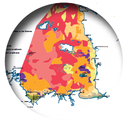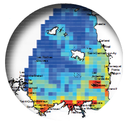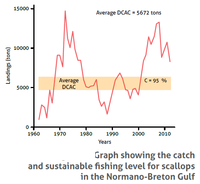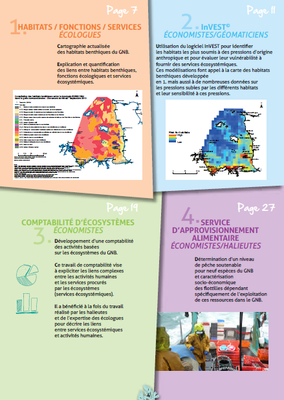5.4.5 Golfe Normand-Breton: Ecosystem Services Assessment Methods and Results

In the Golfe Normand-Breton, ecosystem services valuation is applied within a broad framework meeting the need to establish a first diagnosis of the «Gulf» macro-ecosystem which has never been done before.
The nature of relations between habitats and ecosystem services is still at the semi-quantitative stage on many of them, due to a lack of knowledge or indicators.
Various valuation tools have been developed and tested in the Golfe Normand-Breton by economists, ecologists and fisheries experts from Ifremer, Université de Bretagne Occidentale and the Station Biologique de Roscoff to try to value as many services as possible during the project.
1. Linking Habitats, Functions and Services
The identification of ecosystem services linked to benthic habitats in the Golfe Normand-Breton, which is specific in that it features all of the Channel marine habitats, was therefore the first step in meeting the goal of a diagnosis.
 Ecologists from the Station Biologique de Roscoff and Ifremer set out to explain and quantify the links that exist between benthic habitats, ecological functions and ecosystem services; «habitat-ecological function» and «habitat-ecosystem service» matrices were thus developed for the benthic habitats.
Ecologists from the Station Biologique de Roscoff and Ifremer set out to explain and quantify the links that exist between benthic habitats, ecological functions and ecosystem services; «habitat-ecological function» and «habitat-ecosystem service» matrices were thus developed for the benthic habitats.
[ Find out more... ]
2. InVEST (Integrated Valuation of Ecosystem Services and Tradeoffs)
 The InVEST software programme was used to identify habitats the most subject to human-induced pressure and to assess their vulnerability in terms of providing ecosystem services. This modelling work uses the map of benthic habitats developed by ecologists as well as a whole load of data on pressure sustained by the various habitats and their sensitivity to it.
The InVEST software programme was used to identify habitats the most subject to human-induced pressure and to assess their vulnerability in terms of providing ecosystem services. This modelling work uses the map of benthic habitats developed by ecologists as well as a whole load of data on pressure sustained by the various habitats and their sensitivity to it.
[ Find out more... ]
3. Ecological accounting
 An activity counting approach based on the Golfe Normand-Breton’s ecosystems aims to explain the complex links that exist between the main ecosystem services and the local economy.
An activity counting approach based on the Golfe Normand-Breton’s ecosystems aims to explain the complex links that exist between the main ecosystem services and the local economy.
[ Find out more... ]
2. Food provisioning services
 To study the offshore fish production service, traditional and empirical approaches were used by fisheries experts and economists to determine a sustainable level of fishing for nine species in the Golfe Normand-Breton and to characterise the socioeconomic contributions/dependencies of fleets on the stocks studied. The nine species are: scallop, whelk, cuttlefish, spider crab, lobster, black sea bream, Dover sole, Venus clam, common skate.
To study the offshore fish production service, traditional and empirical approaches were used by fisheries experts and economists to determine a sustainable level of fishing for nine species in the Golfe Normand-Breton and to characterise the socioeconomic contributions/dependencies of fleets on the stocks studied. The nine species are: scallop, whelk, cuttlefish, spider crab, lobster, black sea bream, Dover sole, Venus clam, common skate.
 Thanks to the information obtained through these valuations, efforts made by society to preserve ecosystems and the related services (e.g. fisheries management, protected areas, improving water quality, etc.) can be compared with the socioeconomic contribution derived from these services by human activities. Carried out by economists, this approach benefitted both from work done by fisheries experts and the expertise of ecologists to describe the links between ecosystem services and human activities.
Thanks to the information obtained through these valuations, efforts made by society to preserve ecosystems and the related services (e.g. fisheries management, protected areas, improving water quality, etc.) can be compared with the socioeconomic contribution derived from these services by human activities. Carried out by economists, this approach benefitted both from work done by fisheries experts and the expertise of ecologists to describe the links between ecosystem services and human activities.
The case study team produced a brochure in french which describes in more detail the four valuation methods used in the Golfe Normand Breton and the key results.

